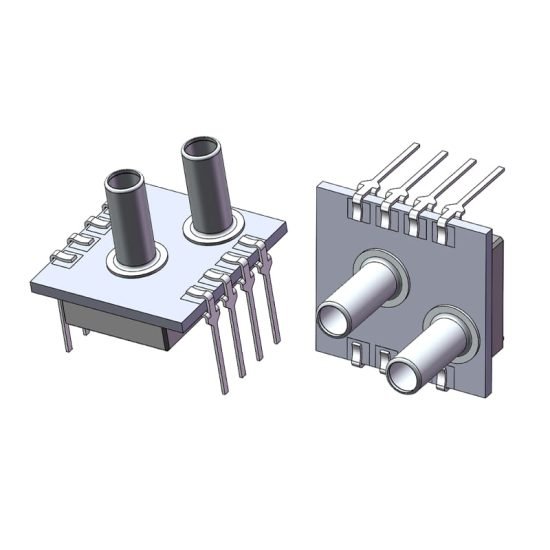Каталог
Серия WF1525 представляет собой МЭМС-датчик низкого давления с диапазонами 5 кПа, 7 кПа и 10 кПа. В устройстве используется трехмерная диафрагменная структура и привод постоянного тока (рекомендуемый ток 1,5 мА), а также реализована полная внутрикристальная температурная компенсация в диапазоне от -10°C до 60°C. Лазерная подстройка фиксирует статическую нулевую и компенсированную нулевую точки. С помощью внешнего резистора и дифференциального усилителя можно добиться точной калибровки диапазона. Корпус представляет собой корпус с короткой трубкой DIP, подходящий для медицинских устройств, вентиляторов, систем отопления, вентиляции и кондиционирования воздуха и т. д. На прилагаемом изображении показан внешний вид DIP с короткой трубкой с двумя портами, соответствующий упаковке WF1525.
1 Соответствие конструкции и модельного ряда
WF1525 использует трехмерную структуру диафрагмы для улучшения чувствительности и линейности и специально разработан для трех небольших полномасштабных диапазонов: 5 кПа, 7 кПа и 10 кПа. Прибор дифференциального типа с типичным диапазоном измерения от –5 кПа до +5 кПа. Во время проектирования механическое напряжение, напряжение корпуса и эффекты теплового расширения оптимизируются с помощью технологического и структурного контроля для уменьшения нелинейности и дрейфа нуля, обеспечения стабильного выходного сигнала в номинальном диапазоне и облегчения прямой замены или интеграции в существующие каналы измерения.

2 Механизм температурной компенсации
Температурная компенсация на уровне чипа WF1525 охватывает диапазон от –10°C до 60°C. Он сочетает в себе заводскую калибровку с внутренней компенсационной сетью для снижения температурной чувствительности и дрейфа нуля. Параметры компенсации записываются в калибровочные таблицы или реализуются через встроенные резисторные сети. При использовании с внешним дифференциальным усилителем достигается оптимальная линейность и контроль ошибок в заданном температурном диапазоне, обеспечивая пригодные для использования и калибруемые сигналы при сложных изменениях температуры окружающей среды.
3 Лазерная подстройка и калибровка нуля
Во время производства лазерная подстройка используется для статической и компенсированной калибровки нуля, точной настройки сопротивлений или микроструктур для коррекции смещения нуля. Лазерная обрезка обеспечивает точную, повторяемую коррекцию и более стабильна, чем традиционные методы обрезки. В сочетании с рабочим процессом калибровки привода постоянного тока при отправке это обеспечивает фиксацию нуля и диапазона в пределах заданной точности, улучшая стабильность производства и долгосрочную стабильность.
4. Привод постоянного тока и внешняя калибровка диапазона.
WF1525 рекомендует использовать привод постоянного тока 1,5 мА. Управление постоянным током стабилизирует выходной сигнал датчика и уменьшает ошибки, вызванные изменениями напряжения питания. Из-за архитектуры привода постоянного тока для продукта требуется параллельный резистор и внешний дифференциальный усилитель. На уровне системы калибровка диапазона достигается путем регулировки внешнего резистора и коэффициента усиления усилителя, что позволяет удовлетворить разнообразные потребности в обработке сигналов и интерфейсах, сохраняя при этом стабильность нуля и высокую линейность.
5. Упаковка, порты и надежность
Во всех вариантах WF1525 используется двойной линейный корпус (DIP) с портами с короткой трубкой, что обеспечивает простоту монтажа и надежную совместимость интерфейсов. Номинальная рабочая температура устройства составляет от –40°C до +85°C, а оптимальная точность и линейность достигаются в диапазоне компенсации от –10°C до 60°C. Конструкция корпуса уравновешивает тепловые пути и изоляцию напряжений, чтобы минимизировать внешнюю нагрузку на диафрагму. Производственные испытания включают проверку дрейфа и статического нуля для обеспечения надежности и постоянства промышленного уровня.
Заключение
WF1525 объединяет чувствительность 3D-диафрагмы, температурную компенсацию на уровне чипа, лазерную подстройку и привод постоянного тока в комбинированное решение для повторяемых, калибруемых измерений низкого давления. Благодаря точной заводской компенсации и внешней калибровке на уровне системы устройство поддерживает стабильность нуля и точность измерений в практических приложениях, подходит для медицинского оборудования, вентиляторов, систем отопления, вентиляции и кондиционирования, измерения расхода и уровня жидкости, а также других сценариев со строгими требованиями к температурной устойчивости и постоянству нулевой точки.
Вышеупомянутое введение лишь поверхностно коснулось области применения технологии датчиков давления. Мы продолжим изучать различные типы сенсорных элементов, используемых в различных продуктах, их работу, их преимущества и недостатки. Если вам нужна более подробная информация о том, что здесь обсуждается, вы можете просмотреть соответствующий контент далее в этом руководстве. Если у вас мало времени, вы также можете нажать здесь, чтобы загрузить подробную информацию об этом руководстве. Данные датчика давления воздуха PDF.
Для получения дополнительной информации о других сенсорных технологиях, пожалуйста, Посетите нашу страницу датчиков.
